
Researchers, including a researcher Hosseini from Engineering Faculty, Near East University, have developed an innovative model to enhance the resiliency of distribution networks, especially in the face of low-probability, high-impact events like windstorms and earthquakes. The study focuses on optimizing the performance of distribution systems (DS) by employing mixed-integer linear programming, with a particular emphasis on integrating renewable energy sources (RESs), stationary battery energy storage systems (SBESSs), and power electric vehicle parking lots (PEV-PLs).
The proposed model utilizes stochastic optimization techniques to address uncertainties related to factors such as upstream grid pricing, wind power, photovoltaic (PV), and active/reactive power for various electrical loads. It also introduces demand response programs (DRP) and interruptible loads to bolster the resiliency of the DS during emergencies. The model is applied and validated on the IEEE 33-bus benchmark test system, showcasing its effectiveness under normal and resilient operation conditions.
The stochastic planning model, as outlined in the study, simultaneously allocates and sizes RESs, PEV-PLs, and SBESS to achieve high penetration levels in DSs under both routine and emergency scenarios. The primary objective is to minimize overall costs, encompassing maintenance and investment costs for renewable energy systems and storage, as well as operating costs during normal and resilient operations.
The model is rigorously tested using real data, considering uncertainties in energy prices, RESs, and different load types over a 12-day period. To handle the complexity introduced by stochastic optimization, an appropriate scenario reduction technique is employed. The study successfully validates the model’s performance in various operational cases, including normal, resilient, and resilient conditions without DRP and PEV-PLs.
Key findings highlight the model’s ability to achieve significant cost savings during normal operation, with a marginal increase in operation and investment costs during resilient operation. Furthermore, by incorporating DRP and PEVs, the model demonstrates substantial overall cost reductions during resilient operation, along with efficient restoration of commercial and residential demands.
This research underscores the practical benefits of integrating renewable energy sources, energy storage, and demand response programs for enhancing the resilience of distribution networks, providing valuable insights for future advancements in sustainable energy planning and emergency management.
More Information:
https://www.sciencedirect.com/science/article/pii/S2352152X23008976